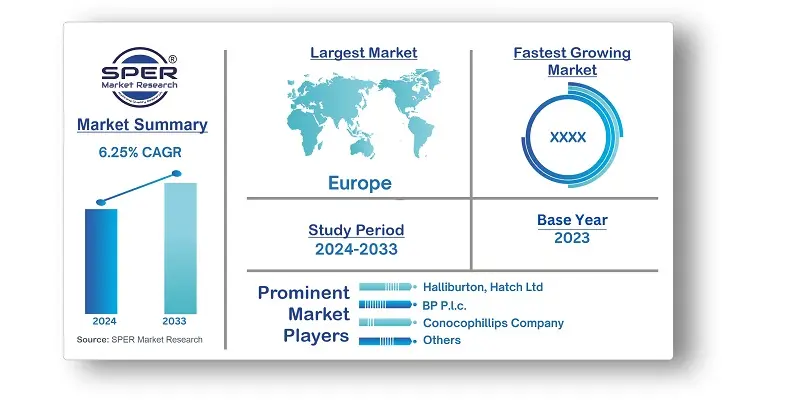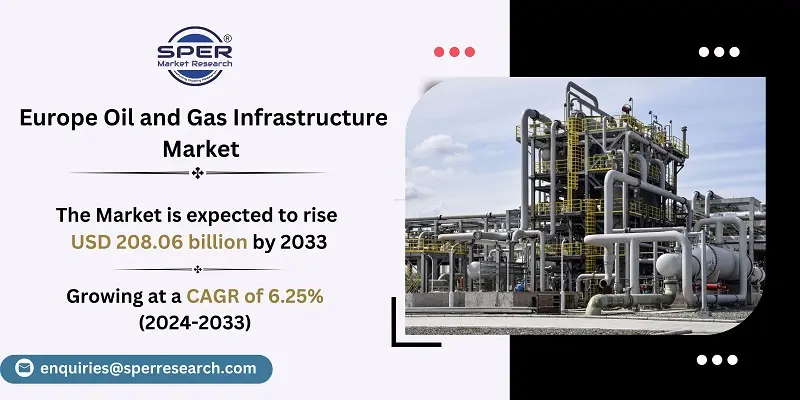
Europe Oil and Gas Infrastructure Market Growth, Size, Trends, Share, Revenue and Future Outlook
Europe Oil and Gas Infrastructure Market Size- By Category- Regional Outlook, Competitive Strategies and Segment Forecast to 2033
| Published: Jun-2024 | Report ID: POAE2444 | Pages: 1 - 153 | Formats*: |
| Category : Power & Energy | |||
- ConocoPhillips stated in November 2021 that it would invest USD 1.46 billion to develop the gas and condensate discovery, Tommeliten, in Norway. The company's investment plan will enable it to create reserves by installing equipment on the seabed that is connected to its current infrastructure facility at Conoco's Ekofisk field.
- ExpressFiber, a single-user fiber optic connection from Halliburton, was introduced in July 2021. It offers precise, direct subsurface readings and cross-well connectivity, enabling fracture monitoring systems on each well pad.


| Report Metric | Details |
| Market size available for years | 2020-2033 |
| Base year considered | 2023 |
| Forecast period | 2024-2033 |
| Segments covered | By Category |
| Regions covered | France, Germany, Italy, Spain, United Kingdom, Rest of Europe |
| Companies Covered | Halliburton, Hatch Ltd, BP P.l.c., Conocophillips Company, TotalEnergies, Chevron Corporation, Baker Hughes Company, Exxon Mobil Corporation, Shell, Royal Vopak, SLB. |
- Oil and Gas Companies
- Infrastructure Development Firms
- Government Agencies and Regulatory Bodies
- Investment Firms and Financial Institutions
- Equipment Manufacturers and Suppliers
- Engineering and Construction Companies
- Research and Development Organizations
- Consulting Firms
| By Category: |
|
- Europe Oil and Gas Infrastructure Market Size (FY’2024-FY’2033)
- Overview of Europe Oil and Gas Infrastructure Market
- Segmentation of Europe Oil and Gas Infrastructure Market By Category (Surface and Lease Equipment, Gathering & Processing, Oil, Gas & NGL Pipelines, Oil & Gas Storage, Refining & Oil Products Transport, Export Terminals)
- Expansion Analysis of Europe Oil and Gas Infrastructure Market
- Problems and Obstacles in Europe Oil and Gas Infrastructure Market
- Competitive Landscape in the Europe Oil and Gas Infrastructure Market
- Impact of COVID-19 and Demonetization on Europe Oil and Gas Infrastructure Market
- Details on Current Investment in Europe Oil and Gas Infrastructure Market
- Competitive Analysis of Europe Oil and Gas Infrastructure Market
- Prominent Players in the Europe Oil and Gas Infrastructure Market
- SWOT Analysis of Europe Oil and Gas Infrastructure Market
- Europe Oil and Gas Infrastructure Market Future Outlook and Projections (FY’2024-FY’2033)
- Recommendations from Analyst
1.1. Scope of the report1.2. Market segment analysis
2.1. Research data source
2.1.1. Secondary Data2.1.2. Primary Data2.1.3. SPER’s internal database2.1.4. Premium insight from KOL’s
2.2. Market size estimation
2.2.1. Top-down and Bottom-up approach
2.3. Data triangulation
4.1. Driver, Restraint, Opportunity and Challenges analysis
4.1.1. Drivers4.1.2. Restraints4.1.3. Opportunities4.1.4. Challenges
4.2. COVID-19 Impacts of the Europe Oil and Gas Infrastructure Market
5.1. SWOT Analysis
5.1.1. Strengths5.1.2. Weaknesses5.1.3. Opportunities5.1.4. Threats
5.2. PESTEL Analysis
5.2.1. Political Landscape5.2.2. Economic Landscape5.2.3. Social Landscape5.2.4. Technological Landscape5.2.5. Environmental Landscape5.2.6. Legal Landscape
5.3. PORTER’s Five Forces
5.3.1. Bargaining power of suppliers5.3.2. Bargaining power of buyers5.3.3. Threat of Substitute5.3.4. Threat of new entrant5.3.5. Competitive rivalry
5.4. Heat Map Analysis
6.1. Europe Oil and Gas Infrastructure Market Manufacturing Base Distribution, Sales Area, Product Type6.2. Mergers & Acquisitions, Partnerships, Product Launch, and Collaboration in Europe Oil and Gas Infrastructure Market
7.1. Europe Oil and Gas Infrastructure Market Size, Share and Forecast, By Category, 2020-20267.2. Europe Oil and Gas Infrastructure Market Size, Share and Forecast, By Category, 2027-20337.3. Surface and Lease Equipment7.4. Gathering & Processing7.5. Oil, Gas & NGL Pipeline7.6. Oil & Gas Storage7.7. Refining & Oil Products Transport7.8. Export Terminals
8.1. Europe Oil and Gas Infrastructure Market Size and Market Share
9.1. Europe Oil and Gas Infrastructure Market Size and Market Share By Region (2020-2026)9.2. Europe Oil and Gas Infrastructure Market Size and Market Share By Region (2027-2033)9.3. France9.4. Germany9.5. Italy9.6. Spain9.7. United Kingdom9.8. Rest of Europe
10.1. Halliburton
10.1.1. Company details10.1.2. Financial outlook10.1.3. Product summary10.1.4. Recent developments
10.2. Hatch Ltd
10.2.1. Company details10.2.2. Financial outlook10.2.3. Product summary10.2.4. Recent developments
10.3. BP P.l.c.
10.3.1. Company details10.3.2. Financial outlook10.3.3. Product summary10.3.4. Recent developments
10.4. Conocophillips Company
10.4.1. Company details10.4.2. Financial outlook10.4.3. Product summary10.4.4. Recent developments
10.5. TotalEnergies
10.5.1. Company details10.5.2. Financial outlook10.5.3. Product summary10.5.4. Recent developments
10.6. Chevron Corporation
10.6.1. Company details10.6.2. Financial outlook10.6.3. Product summary10.6.4. Recent developments
10.7. Baker Hughes Company
10.7.1. Company details10.7.2. Financial outlook10.7.3. Product summary10.7.4. Recent developments
10.8. Exxon Mobil Corporation
10.8.1. Company details10.8.2. Financial outlook10.8.3. Product summary10.8.4. Recent developments
10.9. Sysco Corporation
10.9.1. Company details10.9.2. Financial outlook10.9.3. Product summary10.9.4. Recent developments
10.10. Shell
10.10.1. Company details10.10.2. Financial outlook10.10.3. Product summary10.10.4. Recent developments
10.11. Royal Vopak
10.11.1. Company details10.11.2. Financial outlook10.11.3. Product summary10.11.4. Recent developments
10.12. Others
SPER Market Research’s methodology uses great emphasis on primary research to ensure that the market intelligence insights are up to date, reliable and accurate. Primary interviews are done with players involved in each phase of a supply chain to analyze the market forecasting. The secondary research method is used to help you fully understand how the future markets and the spending patterns look likes.
The report is based on in-depth qualitative and quantitative analysis of the Product Market. The quantitative analysis involves the application of various projection and sampling techniques. The qualitative analysis involves primary interviews, surveys, and vendor briefings. The data gathered as a result of these processes are validated through experts opinion. Our research methodology entails an ideal mixture of primary and secondary initiatives.



Frequently Asked Questions About This Report
PLACE AN ORDER
Year End Discount
Sample Report
Pre-Purchase Inquiry
NEED CUSTOMIZATION?
Request CustomizationCALL OR EMAIL US
100% Secure Payment






Related Reports
Our Global Clients
Our data-driven insights have influenced the strategy of 200+ reputed companies across the globe.






















